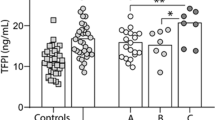Abstract
Several chemokines/chemokine receptors such as CCR7, CXCR4 and CXCR5 attract chronic lymphocytic leukemia (CLL) cells to specific microenvironments. Here we have investigated whether the CX3CR1/CX3CL1 axis is involved in the interaction of CLL with their microenvironment. CLL cells from 52 patients expressed surface CX3CR1 and CX3CL1 and released constitutively soluble CX3CL1. One third of these were attracted in vitro by soluble CX3CL1. CX3CL1-induced phosphorylation of PI3K, Erk1/2, p38, Akt and Src was involved in induction of CLL chemotaxis. Leukemic B cells upregulated CXCR4 upon incubation with CX3CL1 and this was paralleled by increased chemotaxis to CXCL12. Akt phosphorylation was involved in CX3CL1-induced upregulation of CXCR4 on CLL. In proliferation centers from CLL lymph node and bone marrow, CX3CL1 was expressed by CLL cells whereas CX3CR1 was detected in CLL and stromal cells. Nurselike cells (NLCs) generated from CLL patient blood co-expressed surface CX3CR1 and CX3CL1, but did not secrete soluble CX3CL1. Only half of NLC cell fractions were attracted in vitro by CX3CL1. In conclusion, the CX3CR1/CX3CL1 system may contribute to interactions between CLL cells and tumor microenvironment by increasing CXCL12-mediated attraction of leukemic cells to NLC and promoting directly adhesion of CLL cells to NLC.
This is a preview of subscription content, access via your institution
Access options
Subscribe to this journal
Receive 12 print issues and online access
$259.00 per year
only $21.58 per issue
Buy this article
- Purchase on Springer Link
- Instant access to full article PDF
Prices may be subject to local taxes which are calculated during checkout





Similar content being viewed by others
References
Chiorazzi N, Rai KR, Ferrarini M . Chronic lymphocytic leukemia. N Engl J Med 2005; 352: 804–815.
Damle RN, Wasil T, Fais F, Ghiotto F, Valetto A, Allen SL et al. Ig V gene mutation status and CD38 expression as novel prognostic indicators in chronic lymphocytic leukemia. Blood 1999; 94: 1840–1847.
Hamblin TJ, Davis Z, Gardiner A, Oscier DG, Stevenson FK . Unmutated Ig V(H) genes are associated with a more aggressive form of chronic lymphocytic leukemia. Blood 1999; 94: 1848–1854.
Matrai Z . CD38 as a prognostic marker in CLL. Hematology 2005; 10: 39–46.
Crespo M, Bosch F, Villamor N, Bellosillo B, Colomer D, Rozman M et al. ZAP-70 expression as a surrogate for immunoglobulin-variable-region mutations in chronic lymphocytic leukemia. N Engl J Med 2003; 348: 1764–1775.
Dohner H, Stilgenbauer S, Benner A, Leupolt E, Krober A, Bullinger L et al. Genomic aberrations and survival in chronic lymphocytic leukemia. N Engl J Med 2000; 343: 1910–1916.
Baggiolini M . Chemokines and leukocyte traffic. Nature 1998; 392: 565–568.
Raffaghello L, Cocco C, Corrias MV, Airoldi I, Pistoia V . Chemokines in neuroectodermal tumour progression and metastasis. Semin Cancer Biol 2009; 19: 97–102.
Pistoia V, Corcione A, Dallegri F, Ottonello L . Lymphoproliferative disorders and chemokines. Curr Drug Targets 2006; 7: 81–90.
Till KJ, Lin K, Zuzel M, Cawley JC . The chemokine receptor CCR7 and alpha4 integrin are important for migration of chronic lymphocytic leukemia cells into lymph nodes. Blood 2002; 99: 2977–2984.
Burkle A, Niedermeier M, Schmitt-Graff A, Wierda WG, Keating MJ, Burger JA . Overexpression of the CXCR5 chemokine receptor, and its ligand, CXCL13 in B-cell chronic lymphocytic leukemia. Blood 2007; 110: 3316–3325.
Burger M, Hartmann T, Krome M, Rawluk J, Tamamura H, Fujii N et al. Small peptide inhibitors of the CXCR4 chemokine receptor (CD184) antagonize the activation, migration, and antiapoptotic responses of CXCL12 in chronic lymphocytic leukemia B cells. Blood 2005; 106: 1824–1830.
Bazan JF, Bacon KB, Hardiman G, Wang W, Soo K, Rossi D et al. A new class of membrane-bound chemokine with a CX3C motif. Nature 1997; 385: 640–644.
Foussat A, Bouchet-Delbos L, Berrebi D, Durand-Gasselin I, Coulomb-L′Hermine A, Krzysiek R et al. Deregulation of the expression of the fractalkine/fractalkine receptor complex in HIV-1-infected patients. Blood 2001; 98: 1678–1686.
Fong AM, Robinson LA, Steeber DA, Tedder TF, Yoshie O, Imai T et al. Fractalkine and CX3CR1 mediate a novel mechanism of leukocyte capture, firm adhesion, and activation under physiologic flow. J Exp Med 1998; 188: 1413–1419.
Imai T, Hieshima K, Haskell C, Baba M, Nagira M, Nishimura M et al. Identification and molecular characterization of fractalkine receptor CX3CR1, which mediates both leukocyte migration and adhesion. Cell 1997; 91: 521–530.
Corcione A, Ferretti E, Bertolotto M, Fais F, Raffaghello L, Gregorio A et al. CX3CR1 is expressed by human B lymphocytes and meditates CX3CL1 driven chemotaxis of tonsil centrocytes. PLoS One 2009; 4: e8485.
Andreasson U, Ek S, Merz H, Rosenquist R, Andersen N, Jerkeman M et al. B cell lymphomas express CX3CR1 a non-B cell lineage adhesion molecule. Cancer Lett 2008; 259: 138–145.
Ferrer A, Ollila J, Tobin G, Nagy B, Thunberg U, Aalto Y et al. Different gene expression in immunoglobulin-mutated and immunoglobulin-unmutated forms of chronic lymphocytic leukemia. Cancer Genet Cytogenet 2004; 153: 69–72.
Shulby SA, Dolloff NG, Stearns ME, Meucci O, Fatatis A . CX3CR1-fractalkine expression regulates cellular mechanisms involved in adhesion, migration, and survival of human prostate cancer cells. Cancer Res 2004; 64: 4693–4698.
Andre F, Cabioglu N, Assi H, Sabourin JC, Delaloge S, Sahin A et al. Expression of chemokine receptors predicts the site of metastatic relapse in patients with axillary node positive primary breast cancer. Ann Oncol 2006; 17: 945–951.
Marchesi F, Piemonti L, Fedele G, Destro A, Roncalli M, Albarello L et al. The chemokine receptor CX3CR1 is involved in the neural tropism and malignant behavior of pancreatic ductal adenocarcinoma. Cancer Res 2008; 68: 9060–9069.
Locatelli M, Boiocchi L, Ferrero S, Martinelli Boneschi F, Zavanone M, Pesce S et al. Human glioma tumors express high levels of the chemokine receptor CX3CR1. Eur Cytokine Netw 2010; 21: 27–33.
Corcione A, Tortolina G, Bonecchi R, Battilana N, Taborelli G, Malavasi F et al. Chemotaxis of human tonsil B lymphocytes to CC chemokine receptor (CCR) 1, CCR2 and CCR4 ligands is restricted to non-germinal center cells. Int Immunol 2002; 14: 883–892.
Montecucco F, Steffens S, Burger F, Da Costa A, Bianchi G, Bertolotto M et al. Tumor necrosis factor-alpha (TNF-alpha) induces integrin CD11b/CD18 (Mac-1) up-regulation and migration to the CC chemokine CCL3 (MIP-1alpha) on human neutrophils through defined signalling pathways. Cell Signal 2008; 20: 557–568.
Burger JA, Tsukada N, Burger M, Zvaifler NJ, Dell′Aquila M, Kipps TJ . Blood-derived nurse-like cells protect chronic lymphocytic leukemia B cells from spontaneous apoptosis through stromal cell-derived factor-1. Blood 2000; 96: 2655–2663.
Tsukada N, Burger JA, Zvaifler NJ, Kipps TJ . Distinctive features of ‘nurselike’ cells that differentiate in the context of chronic lymphocytic leukemia. Blood 2002; 99: 1030–1037.
Mohle R, Failenschmid C, Bautz F, Kanz L . Overexpression of the chemokine receptor CXCR4 in B cell chronic lymphocytic leukemia is associated with increased functional response to stromal cell-derived factor-1 (SDF-1). Leukemia 1999; 13: 1954–1959.
Cambien B, Pomeranz M, Schmid-Antomarchi H, Millet MA, Breittmayer V, Rossi B et al. Signal transduction pathways involved in soluble fractalkine-induced monocytic cell adhesion. Blood 2001; 97: 2031–2037.
Burger JA, Ghia P, Rosenwald A, Caligaris-Cappio F . The microenvironment in mature B-cell malignancies: a target for new treatment strategies. Blood 2009; 114: 3367–3375.
Della Rocca GJ, Maudsley S, Daaka Y, Lefkowitz RJ, Luttrell LM . Pleiotropic coupling of G protein-coupled receptors to the mitogen-activated protein kinase cascade. Role of focal adhesions and receptor tyrosine kinases. J Biol Chem 1999; 274: 13978–13984.
Luttrell LM, Hawes BE, van Biesen T, Luttrell DK, Lansing TJ, Lefkowitz RJ . Role of c-Src tyrosine kinase in G protein-coupled receptor- and Gbetagamma subunit-mediated activation of mitogen-activated protein kinases. J Biol Chem 1996; 271: 19443–19450.
Rajagopal S, Kim J, Ahn S, Craig S, Lam CM, Gerard NP et al. Beta-arrestin- but not G protein-mediated signaling by the ‘decoy’ receptor CXCR7. Proc Natl Acad Sci USA 2010; 107: 628–632.
Schmid C, Isaacson PG . Proliferation centres in B-cell malignant lymphoma, lymphocytic (B-CLL): an immunophenotypic study. Histopathology 1994; 24: 445–451.
Nishio M, Endo T, Tsukada N, Ohata J, Kitada S, Reed JC et al. Nurselike cells express BAFF and APRIL, which can promote survival of chronic lymphocytic leukemia cells via a paracrine pathway distinct from that of SDF-1alpha. Blood 2005; 106: 1012–1020.
Deaglio S, Vaisitti T, Bergui L, Bonello L, Horenstein AL, Tamagnone L et al. CD38 and CD100 lead a network of surface receptors relaying positive signals for B-CLL growth and survival. Blood 2005; 105: 3042–3050.
Acknowledgements
We thank Dr Salvatore Casciaro, from the Department of Internal Medicine, University of Genova, Italy, for providing a few CLL samples, Dr A Pistorio from the Epidemiology and Biostatistics Unit, IRCSS G. Gaslini of Genoa, Italy, for the help in statistical analysis, Dr Carla Guarnotta for the help in immunohistochemical analysis and Dr Paolo Fardin for supervising PCR experiments. The work has been supported by grants from Progetti Strategici Oncologici, Ministero della Salute 2006 to AC and VP, from AIRC to VP, and from Bando Giovani Ricercatori 2008, Ministero della Salute and AIRC to SD.
Author information
Authors and Affiliations
Corresponding author
Ethics declarations
Competing interests
The authors declare no conflict of interest.
Additional information
Supplementary Information accompanies the paper on the Leukemia website
Rights and permissions
About this article
Cite this article
Ferretti, E., Bertolotto, M., Deaglio, S. et al. A novel role of the CX3CR1/CX3CL1 system in the cross-talk between chronic lymphocytic leukemia cells and tumor microenvironment. Leukemia 25, 1268–1277 (2011). https://doi.org/10.1038/leu.2011.88
Received:
Revised:
Accepted:
Published:
Issue Date:
DOI: https://doi.org/10.1038/leu.2011.88
Keywords
This article is cited by
-
Aberrantly expressed Wnt5a in nurse-like cells drives resistance to Venetoclax in chronic lymphocytic leukemia
Cell Death Discovery (2022)
-
CX3CR1 positively regulates BCR signaling coupled with cell metabolism via negatively controlling actin remodeling
Cellular and Molecular Life Sciences (2020)
-
CTHRC1 promotes M2-like macrophage recruitment and myometrial invasion in endometrial carcinoma by integrin-Akt signaling pathway
Clinical & Experimental Metastasis (2019)
-
Abnormalities in chemokine receptor recycling in chronic lymphocytic leukemia
Cellular and Molecular Life Sciences (2019)
-
Transcriptome analysis of G protein-coupled receptors in distinct genetic subgroups of acute myeloid leukemia: identification of potential disease-specific targets
Blood Cancer Journal (2016)



